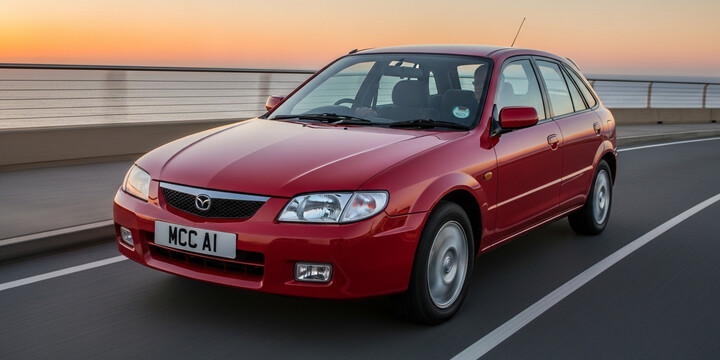
MAZDA 323 (1996-03) 5DR FASTBACK 2.0 DI TURBO AC
The MAZDA 323 (1996-03) 5DR FASTBACK 2.0 DI TURBO AC is a distinctive hatchback that offers a blend of style and practicality, making it a popular choice in the used car market. Known for its sporty design and reliable performance, this model appeals to drivers looking for an affordable yet fun-to-drive vehicle. With its turbocharged engine, the 2.0 DI TURBO AC variant provides a spirited driving experience, making it well-suited for city commuting and everyday journeys. Typically used by individuals and small families, this car balances comfort, efficiency, and sporty appeal, especially appreciated by those seeking a reliable second car or a lively first vehicle.
What sets the MAZDA 323 5DR apart is its reputation for durability and distinctive design, coupled with good fuel economy for its class. It is often compared favourably to its rivals for its robustness and distinctive style, making it a standout choice among compact hatchbacks from the late '90s and early 2000s. With an average mileage of around 110,300 miles and a typical valuation of approximately £605, this model is an interesting option for budget-conscious buyers seeking a car with character and a proven track record. Overall, the MAZDA 323 5DR FASTBACK 2.0 DI TURBO AC remains an appealing pick for those wanting a fun, dependable, and stylish used car.

average use

The latest recorded mileages for the Mazda 323 (1996-03) 5DR Fastback 2.0 Di Turbo AC indicate a split between two key ranges: 50% of the vehicles have mileage between 80,000 and 90,000 miles, while the remaining 50% are between 130,000 and 140,000 miles. This suggests a notable variation in the mileage of these vehicles, possibly reflecting differences in usage, ownership history, or maintenance patterns for this model.

vehicle values

The data indicates that for the Mazda 323 (1996-03) 5DR Fastback 2.0 Di Turbo AC, all private sale valuations fall within the £0 to £1,000 range. This suggests that the vehicle is generally considered to have a low market value in private transactions, which could be attributed to its age, condition, or market demand. Overall, potential buyers and sellers should expect the vehicle to be valued at the lower end of the spectrum, highlighting limited resale price potential in the current market.

production years

The data indicates that for the Mazda 323 (1996-03) 5DR Fastback 2.0 DI Turbo AC, all recorded vehicles in the sample were manufactured in 2001. This suggests that, within the dataset, there is a uniform manufacturing year for this model, which could imply limited variation or data collection focus for this particular year. It's worth noting that the model spans from 1996 to 2003, but the data points to 2001 as the sole manufacturing year represented.

colour popularity

The data indicates that all sampled Mazda 323 (1996-03) 5-door fastback 2.0 DI Turbo AC vehicles have a silver paint colour, accounting for 100% of the sample. This suggests that silver is the overwhelmingly predominant, and possibly the only, colour option for this model in the dataset, reflecting a strong manufacturer preference or other market factors during that production period.

ownership cycle

The data indicates that for the Mazda 323 (1996-03) 5DR Fastback 2.0 DI Turbo AC, half of the vehicles have had only 2 registered keepers, while the remaining half have had 4 registered keepers. This distribution suggests that the majority of these vehicles tend to be maintained by a small number of owners, but there is also a significant portion that has changed hands multiple times. This variation in ownership could reflect differences in vehicle usage, ownership longevity, or resale patterns within this model.

engine choices

Based on the available data for the Mazda 323 (1996-03) 5DR Fastback 2.0 DI Turbo AC, all recorded vehicles are equipped with a diesel engine and have an engine capacity of 100%. Notably, since the model specified is a 2.0 DI Turbo, the consistent mention of diesel fuel aligns well with expectations for this type of engine. However, there is no variation or specific engine capacity detail given in the data, which suggests a uniformity across the sampled vehicles.












